Gustav Klimt Jewelry When Did It Originate Art Nouveau Jewelry
iii.2: Art Nouveau (1890-1914)
- Folio ID
- 134914
Art Nouveau's design brought an ornamental, decorative style of artwork based on long linear lines, moving asymmetrically throughout the design. Artists frequently used the shapes of nature; insects and their wings or how the flower grows and twists. The style was practical to painting, prints, architecture, glass, furniture, and jewelry, often detailed and created with multiple materials. Starting around the 1890s in Europe and America, the movement continued almost until Globe War I and was influenced by Japanese fine art Ukiyo-e. Henri de Toulouse-Lautrec brought acceptability forward with his dramatic posters of women, not in traditional scenes, created with dramatic lines and colors. The motion likewise had elements of Rococo, using gilt gilded or luxurious materials. Women became one of the major themes. During this period, women were frequently "kept every bit virtual pets, prepare on marble pedestals and fabricated to feel helpless and therefore desirable."[1] Women's clothing was restrictive at the first of the century until women started to become employed, needing free-flowing clothing instead of corseted Victorian dress. Art Nouveau artists tended to portray women every bit playmates, posed in provocative stances and wearing decorative baubles.
Critics and historians accept been in disagreement almost the characterization of art and the segregation of painting and sculptures in a fine arts category and the rest into decorative arts. Art Nouveau bridged the statement, incorporating designs into furnishings, architecture, or other decorative forms, embracing the idea fine art should be institute as function of ordinary life. Female forms, plants, and flowers became common subjects incorporated into the designs. The artists pressed beyond the limits, adding unusual patterns and beauty to any object, pushing the boundaries of classical or predictable images. Artists included are:
Artist in this section:
- Gustav Klimt (1862-1918)
- Alphonse Mucha (1860-1939)
- Antoni Gaudi (1852-1926)
- Louis Comfort Tiffany (1848-1933)
- Virginia Frances Sterrett (1900-1931
Gustav Klimt
Gustav Klimt (1862-1918) was born in Austria and studied art at the Vienna School of Decorative Arts. He started his studio specializing in painting murals with a classical mode, receiving many commissions for Vienna's public buildings. Effectually the age of thirty-five, he helped create a new group of artists who wanted to develop their styles independent of existing standards. Klimt did paint landscapes, although his primary interest was the figure. In 1894, he was hired to paint murals at the University of Vienna, paintings called pornographic and radical and non ever hung in the building. When the SS forces of Nazi Germany were retreating in World War 2, they destroyed all three of the mural paintings equally unacceptable.
After he failed in Vienna, Klimt started what many called his 'gilt phase,' when he used gold leafage on his paintings. He had traveled to Italy and was motivated by the Byzantine mosaics and the use of aureate. Klimt used the concepts of gold in his paintings and was very successful with the style, developing a set of patrons. When he painted a subject field, they usually had to sit for long periods while he painted the spectacular detail. Most of his paintings followed a similar theme during his gold periods, dominated by a woman, frequently in erotic positions. Adele Bloch-Bauer'south Portrait (5.two.2) was completed during the pinnacle of Klimt'south gold period and career. He mixed the smoother, natural view of her confront and hands with the brilliant, reflective, and geometric layers of mosaic-like shapes forming the images of the chair and wearing apparel against the golden background. Klimt used a mix of gold and silver leaf with oil pigment fabricated with a binder of chalk. Her husband commissioned the painting, and afterward her decease, along with his other art collection, the portrait was seized by Nazi Deutschland. After the state of war, the painting was located in a gallery housing other works taken past the Nazis. In 1998, later on the gallery refused to release the portrait to the legal heirs and a claim was made to the United states of america Supreme Court. Their ruling returned the painting and other works to their legal heirs.
The Iii Ages of Women (5.2.1) demonstrates Klimt's allegorical subjects, the small-scale child held by the young woman beside the older adult female who bows her head, the symbols of passing the time. Klimt had seen a sculpture of Rodin with an older woman and used the aforementioned torso shape for the painting. Originally, the background was painted with his usual gold color; however, the subject area matter did not fit the color, and he changed to a darker palette.
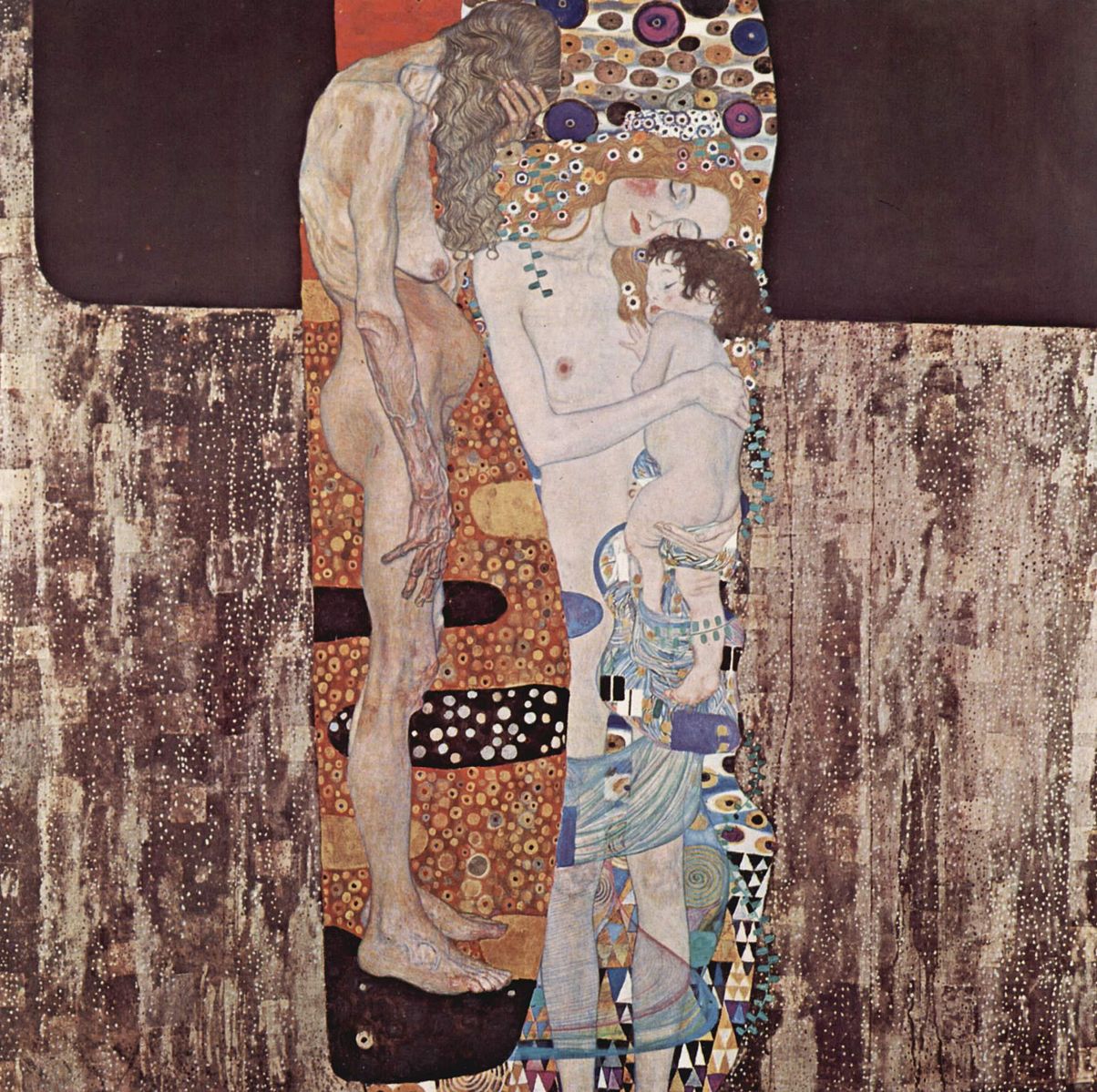
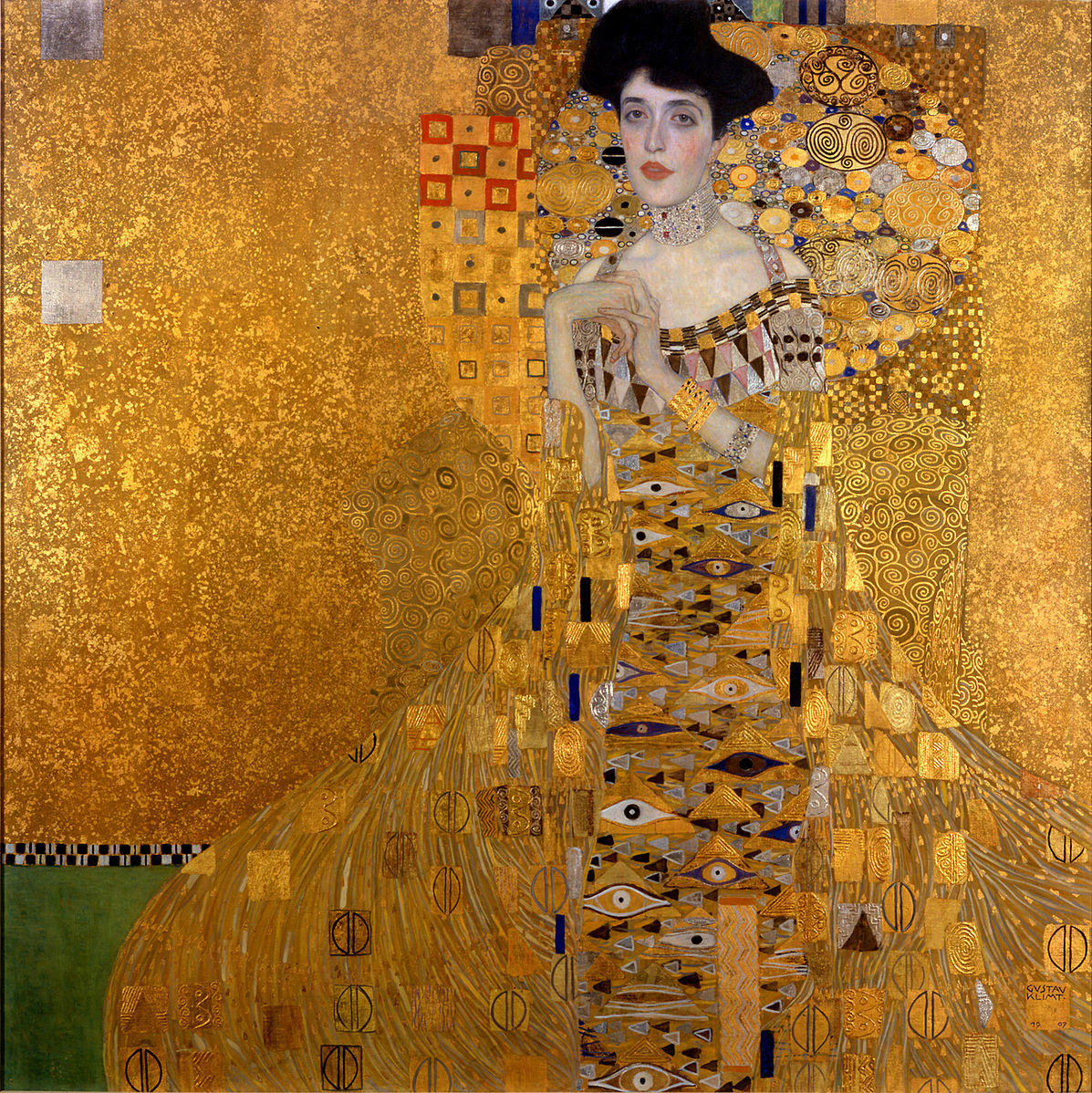
The Kiss (5.2.3) is the nigh well-known of Klimt'southward paintings representing his gold period. Using a square canvas, he practical oil paint with multiple layers of gilded foliage. The image portrays a couple embracing; his sumptuous robe with squares is intertwined with her slender dress decorated with circles. Her full face is seen while the man's face is hidden in the kiss. When Klimt painted the image at the age of 45, he lived with two of his sisters and his mother, a seemingly respectable life that hid his continual affairs with multiple women and was believed to take fathered fourteen children. Historians suggest this painting reflects his continual involvement in eroticism equally the couple's intimacy is evident, although partially subconscious in the opulence, standing in a meadow of flowers.
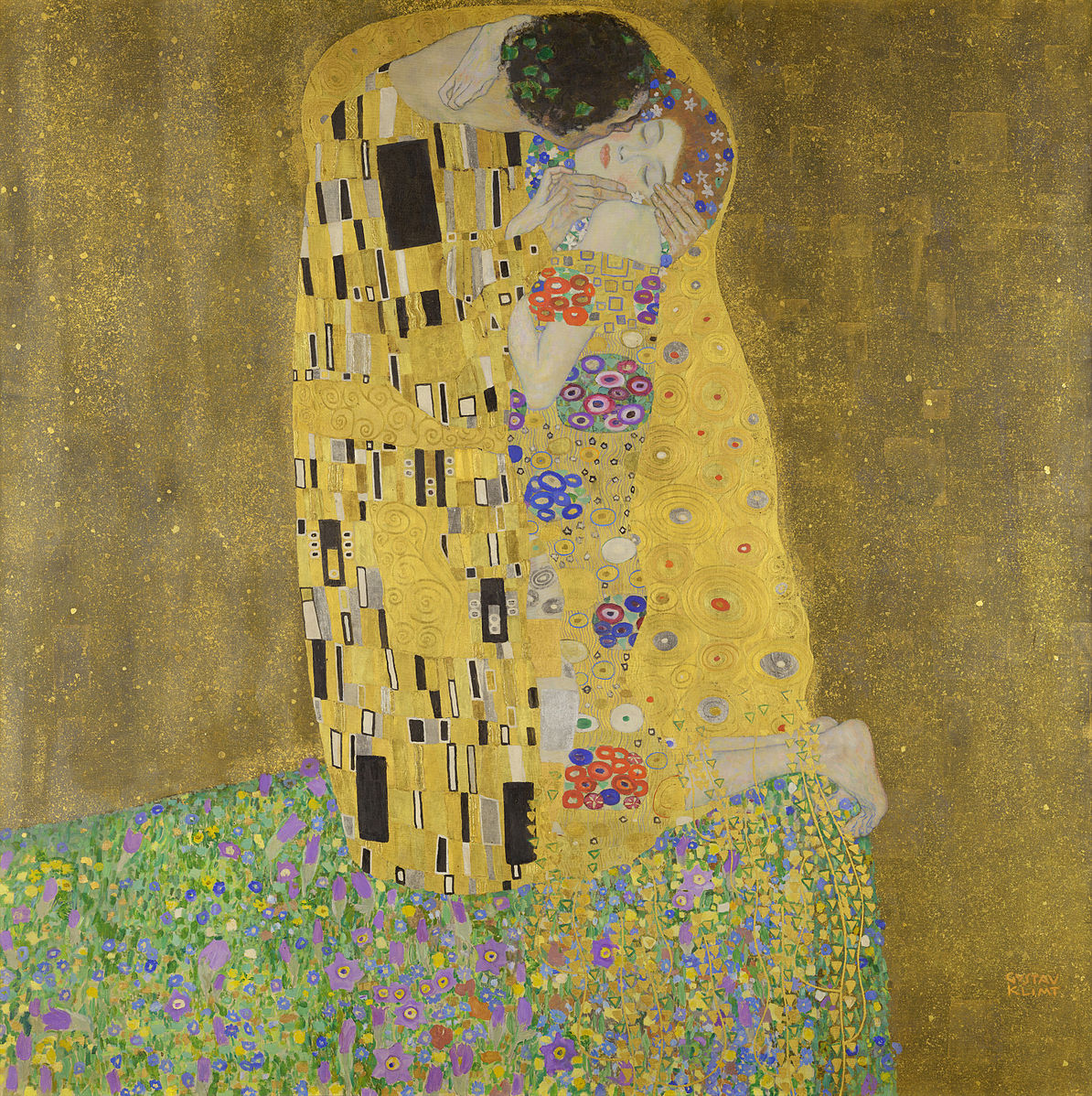
Alphonse Mucha
Alphonse Mucha (1860-1939), born in an area now part of the Czech republic, was known for his souvenir to pigment and sing from an early on age. After applying to the Academy of Fine Arts in Prague for training, he went to Vienna and worked painting scenery for the theater. When the theater burned down, he traveled to other cities in the expanse, learning to paint murals until 1 of his patrons paid for Mucha to go to Paris and study. Some other Czech artist in Paris was an illustrator, and Mucha decided to effort analogy to make money. In 1894, the actress Sarah Bernhardt, in Paris for a new opening, went to the publishing house where Mucha happened to be working, and she asked him to create a poster on a brusk schedule. This started his reputation, and he connected to brand posters, production labels, tile panels, letterheads, and other commercial endeavors, all based on compositions with natural colors and hues and the sensuous fine art nouveau curved lines.
Mucha's starting time poster was Gismonda (v.2.four), the advertisement for Sarah Bernhardt'due south upcoming play, a relationship that lasted for years equally he fabricated several unlike posters for her plays. The posters were hung all over Paris, giving Mucha instant fame. The subtle colors and long shape became characteristic of many of his posters; the Mucha manner. He assembled the words and palm branch to form an arch over her head, a trademark he too used in multiple posters. In Paris, a champagne company deputed the affiche Moet & Chandon Cremant Imperial (5.2.5) to advertise their new production in the marketplace. Mucha used soft blues, whites, pink, and brown colors, hoping to give the poster a sophisticated wait for the expensive champagne. He added his characteristic swirling lines and flowers in his technique, much similar a signature to demonstrate his piece of work.
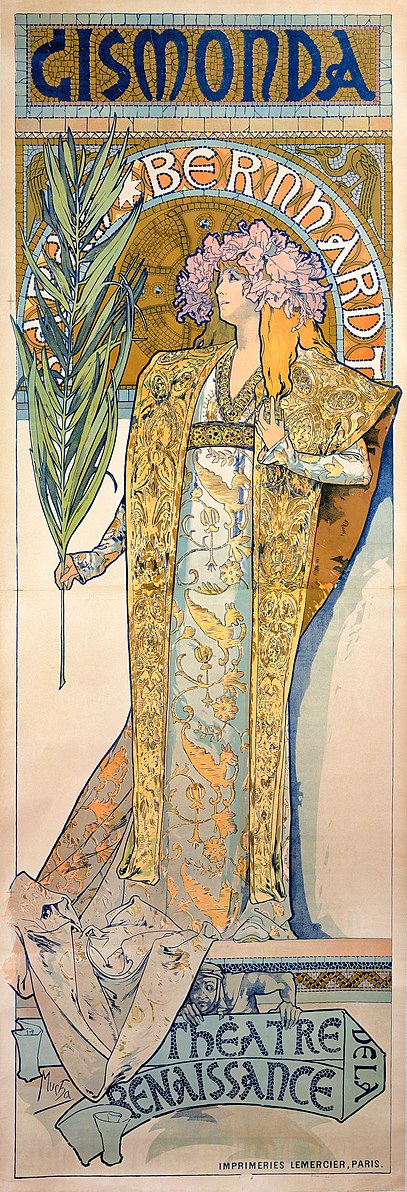
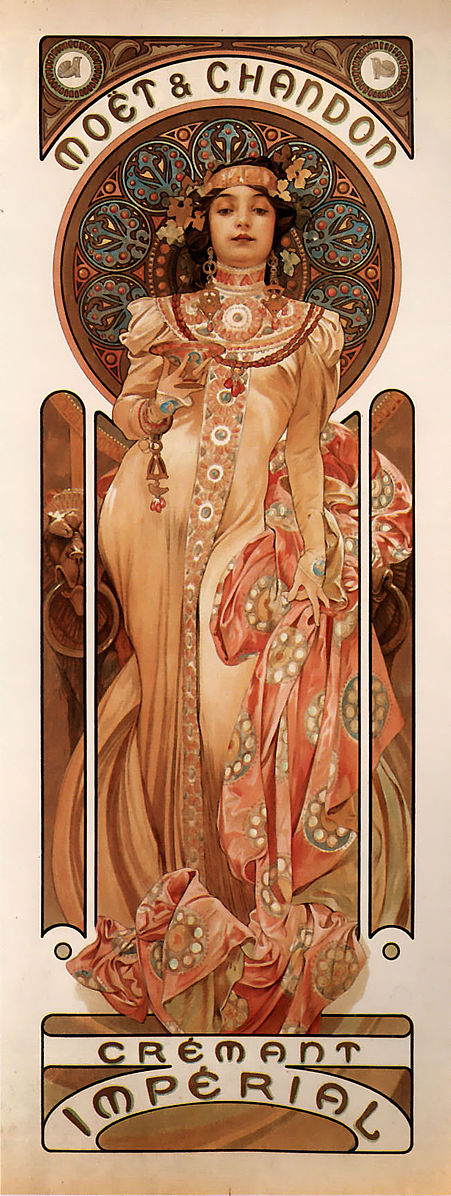
When Mucha was forty-3, he went back to his original habitation and painted the monumental images named The Slav Epic, a tribute to the history of the Slavic people in the expanse. Each scene in the twenty immense canvases portrayed a wide range of specific historical events. Fortunately, he was able to obtain funding from an American philanthropist to back up the projection, including renting a castle with enough space to hang the huge canvases. Ten of the paintings were based on Czech history, and the other x on events throughout the Slavic expanse, which took Mucha over fifteen years. The entire set was given to the Urban center of Prague to celebrate its 10th anniversary of liberty. The Slav Epic No. 5 King Premysl Otakar 2 of Bohemia (5.two.6) portrays the rex famous for his military capabilities and wealth from silverish mines. He united many of the other fiefdoms and brought peace. The painting depicts the king greeting attendees at his niece'due south wedding; the background tent was erected inside the chapel.Slav Epic No. 6 The Coronation of the Serbian Tsar Stefan Dusa due north (v.two.7) portrays the procession of the tsar who achieved multiple armed forces victories, expanding his territory. Tsar Dusan is continuing in the middle with others holding his robe, young girls leading the procession to represent the new generation of promise.
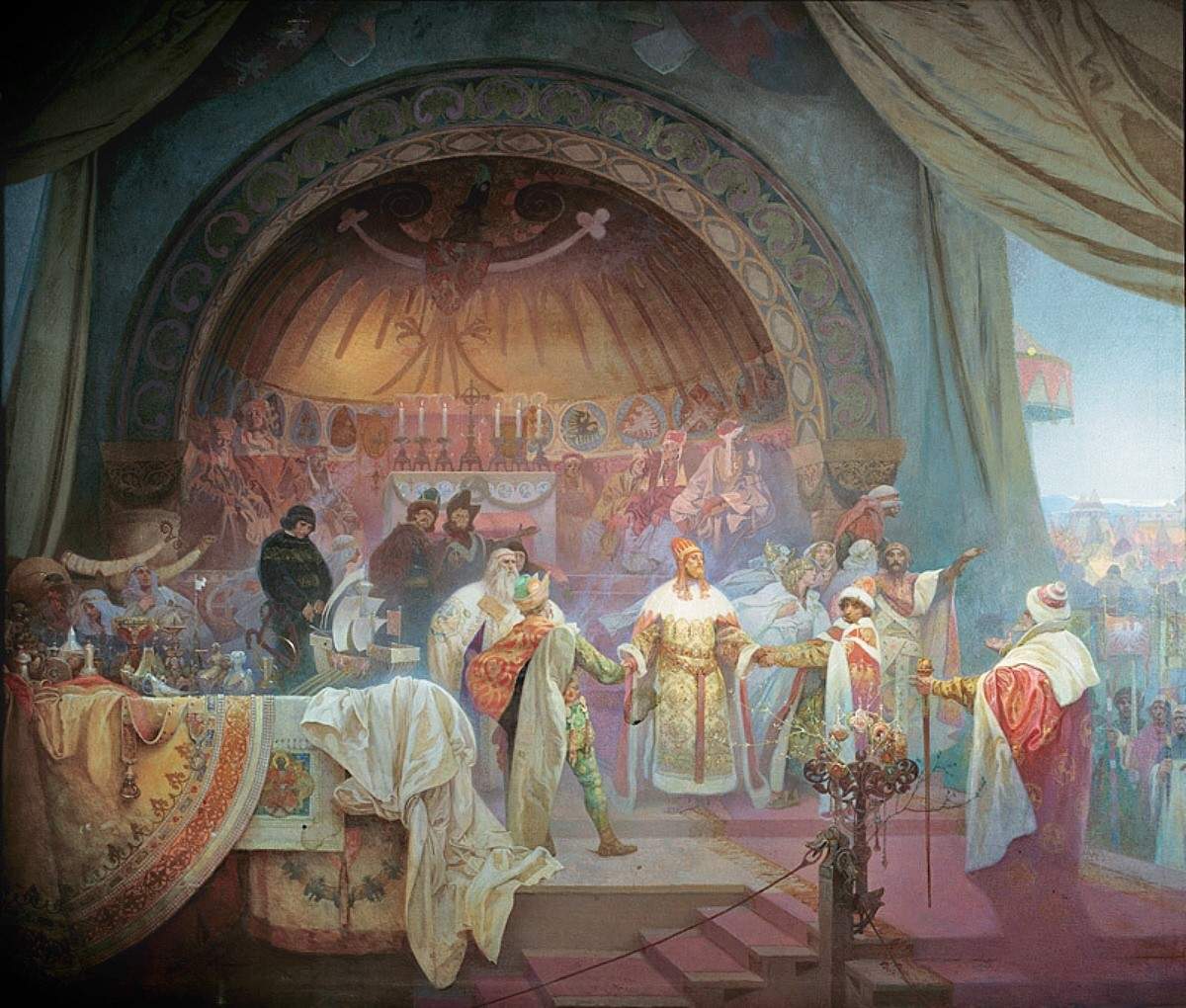
.jpg?revision=1)
Antoni Gaudi
Antoni Gaudi (1852-1926), born in the Catalonia area of Spain, was a child with poor health who was recognized early on for his artistic abilities. He studied compages and the humanities, quickly receiving commissions, earning him a solid reputation and a sponsoring patron who significantly helped his career. Gaudi understood the elements of a building, how to forge fe, the look of mosaics and stained drinking glass, and how space was filled, all helping him develop his style as Gaudi incorporated an organic feeling with curved surfaces in his designs of buildings. He used colorful ceramic tiles, patterned bricks, and unusual metalwork arranged in animated patterns. His distinctive manner was termed Catalan Modernism, a new ornamental utilise of materials formed into geometric shapes
In 1883, Gaudi was given the job of constructing the cathedral in Barcelona, La Sagrada Familia (5.ii.8). Although plans were already completed, Gaudi completely redesigned the concepts, making the cathedral his style. He wanted a building that could stand up without external buttresses or internal braces and used tilted columns to hold the vaulted ceilings. Past 1910, the very religious Gaudi stopped whatsoever other work to focus on the cathedral, even living in the workshop. When he died in 1926, the cathedral was however unfinished; just one of the four towers had been completed, the rest of the edifice is still nether construction today. Some historians described the cathedral as outstanding and creative architecture, while others thought information technology was the strangest-looking building.
Gaudi knew the completed construction of the church building would continue beyond his lifetime and he wrote, "In that location is no reason to regret that I cannot cease the Church building. I volition grow old, but others will come up after me. What will e'er exist conserved is the spirit of the work, simply its life depends on the generations it is handed down to…"[2] Today, La Sagrada Familia is in the process of boosted construction to complete Gaudi's design by 2026, the 100th ceremony of Gaudi's death, calculation six towers and incorporating the elaborate decorative scheme of Gaudi.
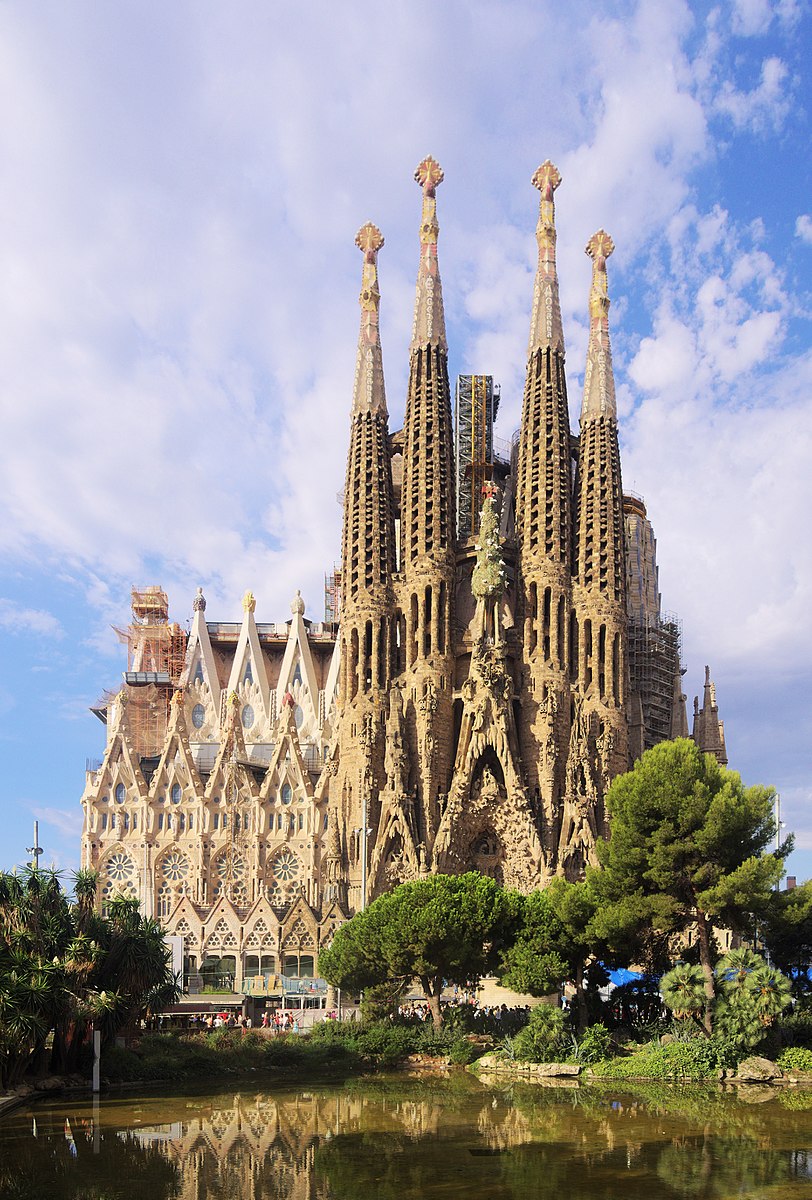
The nave inside the cathedral (five.2.9) rose to forty-five meters and was constructed to class a hyperboloid vault, a belfry construction that curves inward instead of post-obit a straight line or curving outward. Gaudi took his ideas from the trees of nature, letting the pillars and branches resemble a tree reaching to the sky, the columns change shapes from square to octagon to a circle, all highly decorated. The commencement façade completed, Gaudi himself worked on, was the nascence (5.two.x) with ornate sculpture and decorations. The front of the façade is oriented to face the sun as it rises in the eastward, three porticos representing faith, promise, and charity, and iv steeples dedicated to four of the saints. Gaudi wanted this façade to be the map for the decorative construction of the cathedral, for others to follow when he was no longer living then they could go along his designs and concepts.
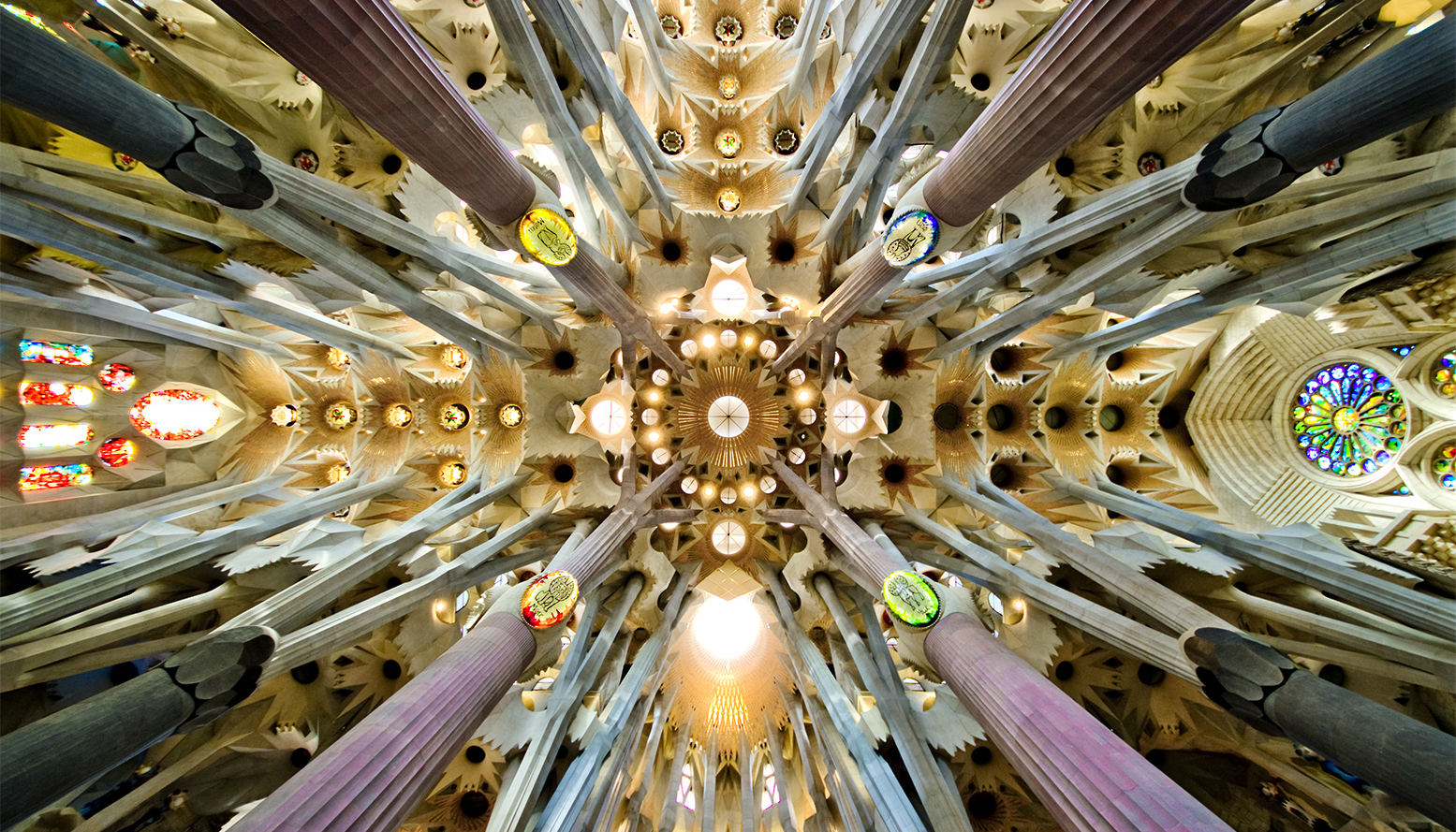
Casa Batllo (5.two.xi) is a building in the middle of Barcelona and is considered a masterpiece of Gaudi, a symbol of Art Nouveau. The building has few straight lines, irregular windows, and sculpted stone and glass facades applied in undulating lines of green-blue colors resembling ripples in the water. Multiple balconies beetle from the sides with oddly shaped doors and wrought fe ornamentation. The interior follows Gaudi'due south concepts of elaborate design, unusual arches, and colorful walls and windows. The roof (v.2.12) arches upward and is described equally the back of a dragon, even covered with shiny ceramic tiles resembling scales. An odd feature is that the turret with a cross on the top is dedicated to St. George, the slayer of dragons.
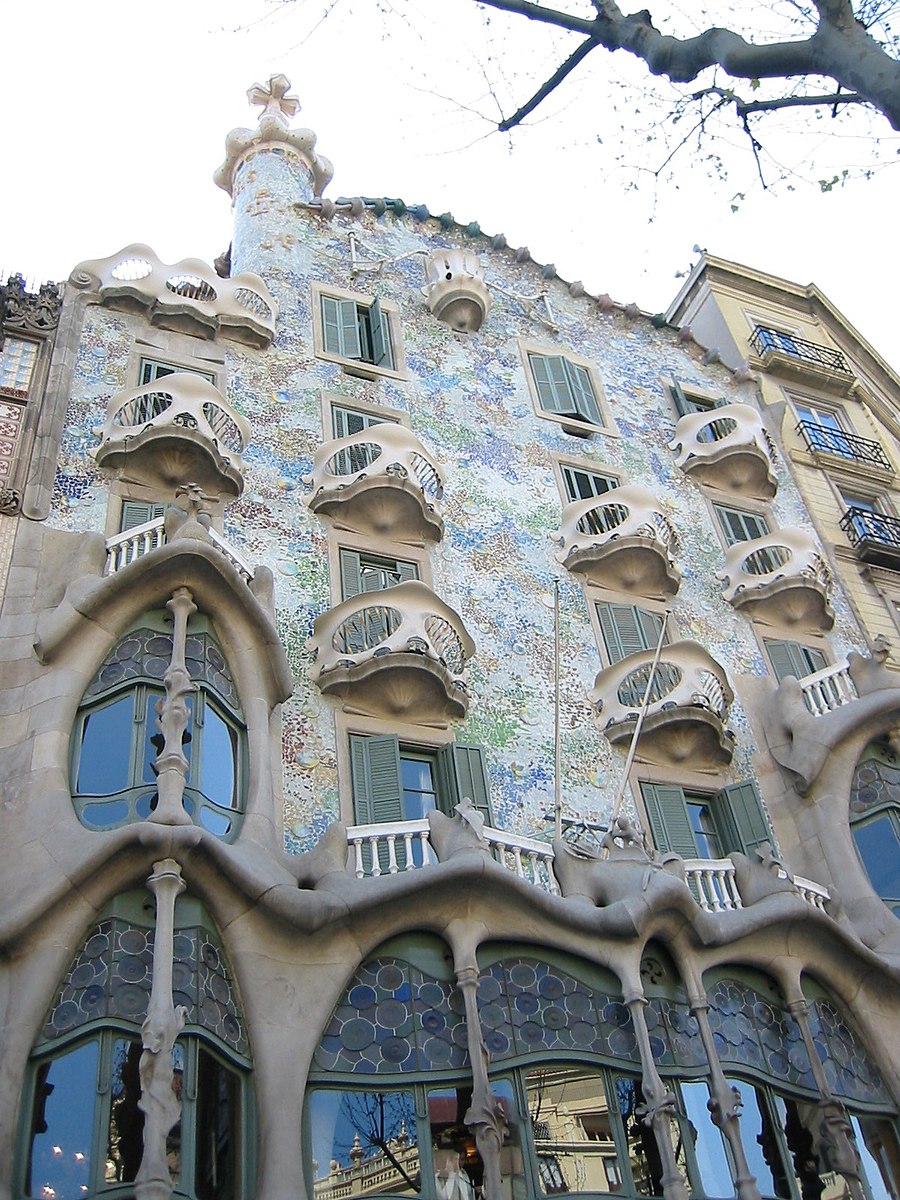
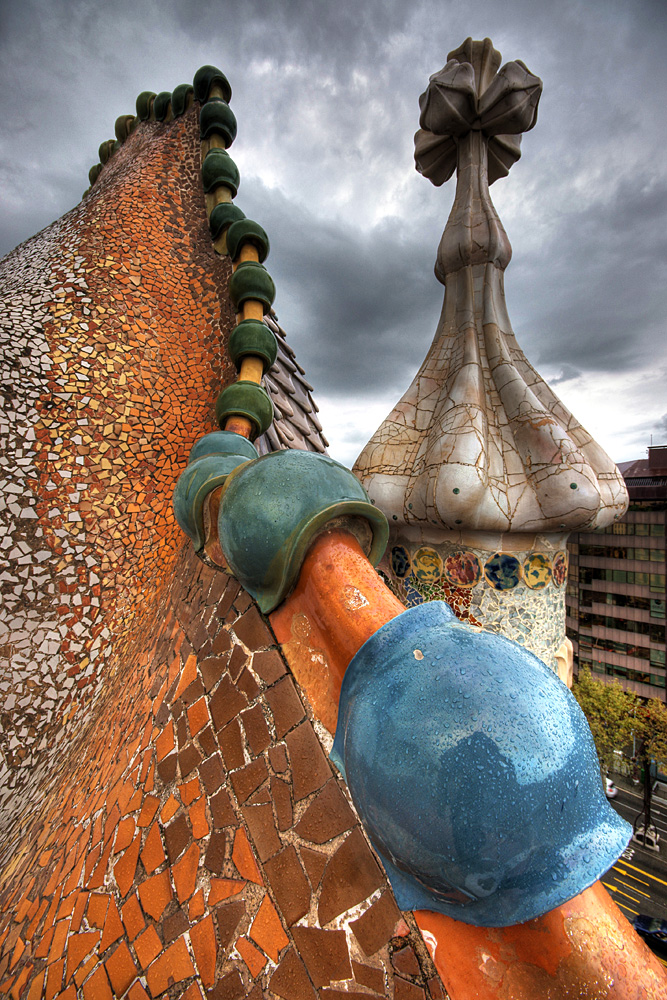
Louis Condolement Tiffany
Louis Comfort Tiffany (1848-1933) started his career every bit a painter and an interior designer before working with glass, producing his first fix of piece of work in 1893 and becoming i of America's well-nigh well-known artists. His father founded the Tiffany Company, making and selling jewelry. Louis Tiffany was able to travel throughout Europe to study different artists before focusing on interior design. One of his earliest projects was a window for his studio, an experiment using nontraditional methods. He incorporated techniques to make the drinking glass announced marbleized with iridescent qualities, added minor pieces of glass for a confetti expect, and rough-cut other pieces. Tiffany congenital his reputation with the unique drinking glass windows, forming his own company, and expanding into lamps and vases.
He developed 'favrile' glass, a new form with color ingrained in the glass, giving an irised quality with a specific look of the colour. He added different metallic oxides to molten glass; the oxides became absorbed as part of the glass and produced a unique iridescent look. The colors were so unusual they had specific names, including Aqua Marine – the colour of deep water with bronze lights in it, a pale light-green with objects…floating in water, or Tel-al-amana, a form of turquoise shading from turquoise to peacock green, and Mazarin Blue, a deep blue with purple shading. The glass appeared very delicate; however, information technology is known for its durability.[3] The ability to create his glass colors freed him from the traditional methods of painting the colors on drinking glass. By making the color function of the glass itself, the glass maintained its true transparency, letting in more light and enhancing the colors in the drinking glass.
Because the glass was fabricated with various colors, striations, and textures, the glassmakers could use long pieces of randomly shaped glass to create the window without painting the glass before firing. The window, Magnolias, and Irises (five.2.thirteen) were fabricated as a memorial, depicting magnolias made from opalescent drapery glass folded along with irises in multiple hues. The closeup section of the window (5.ii.14) Tiffany installed in his studio displays his techniques. The white glass in the upper function demonstrates Tiffany'southward experiment with the confetti wait, embedding pocket-sized pieces of drinking glass. He also used large pieces of crude drinking glass in the window, developing a dimensional advent. The marbled opalescence drinking glass let the light shine through the multiple colors he created in the drinking glass.
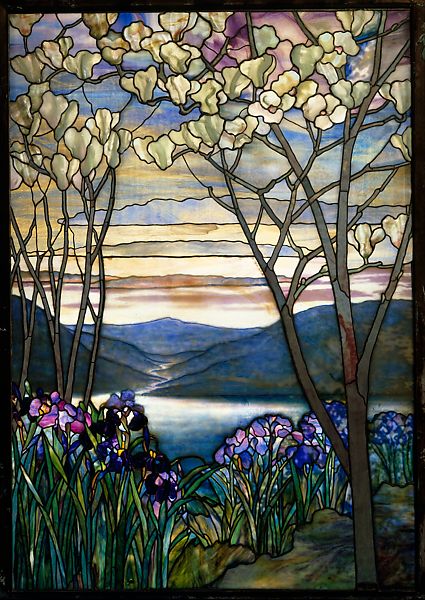
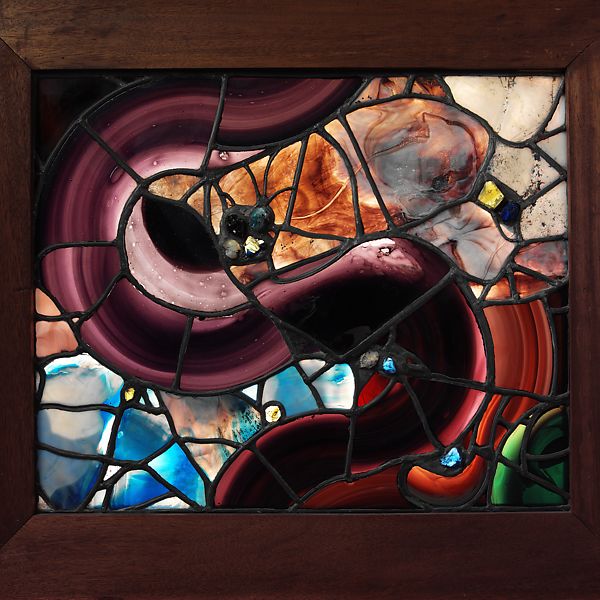
The water-lily lamp (five.2.15) is Tiffany'south about well-known design. The base has a group of lily pads whose stems movement upwards the base and tumble out of the summit of the shade to hold the blossoms. Tiffany used an assortment of glass types, alternating colors, and the light of the lamp, highlighting each flower's opalescent look.
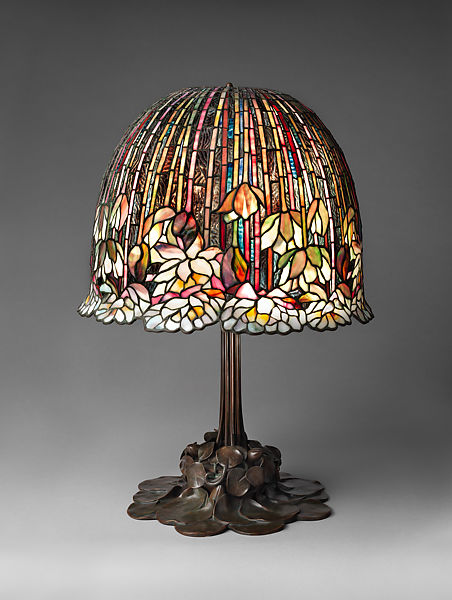 Effigy \(\PageIndex{xv}\): Water-lily lamp (1904-xv, leaded favrile glass and statuary, shade 37.one cm loftier)Public Domain
Effigy \(\PageIndex{xv}\): Water-lily lamp (1904-xv, leaded favrile glass and statuary, shade 37.one cm loftier)Public DomainVase 1 (v.2.16) is an example of the hundreds of vase styles made by his company. The glass was originally articulate, then a layer of chemicals was added to the interior, giving it the aureate luster. Different oxides were added to create the flowers and leaves randomly around the bulbous top one-half of the vase resembling an inverted pear. Tiffany liked the pattern so much; he fabricated a series of morning time glory vases. Vase 2 (5.2.17) is part of the jack-in-the-pulpit series. The cup department resembles a flower with the top half flattened and opened. The exterior of the rim is ruffled; the iridescent color on the top adult when the molten glass was expanded to create thin fissures and give the broad rim a feathery manifestation.
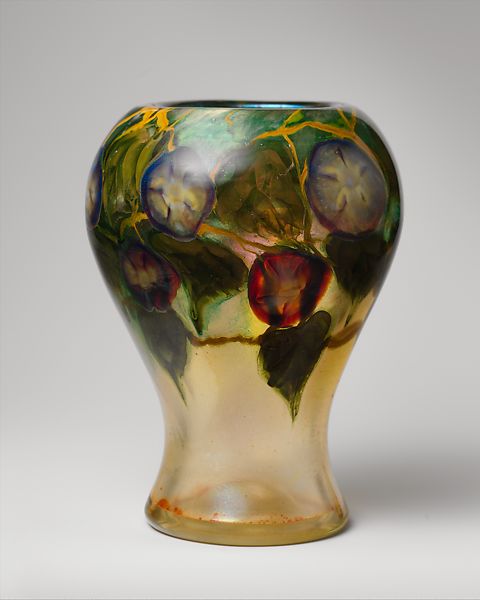
Virginia Frances Sterrett
Virginia Frances Sterrett (1900-1931) was from Chicago, Illinois, and as a child, chose to depict instead of socializing with others. When her begetter died, the family went to Missouri, and she won numerous awards at the state fair, then returned to Chicago to report art. At the age of xix, her health began to fail when she was infected with tuberculosis. Fortunately, she received a commission from the Penn Publishing Company in 1920 to pattern illustrations for the book Sometime French Fairy Tales by Comptesse de Segur. Sterrett created some of the images in watercolor and others in pen and ink. Princess Rosalie (five.ii.18) and The Dream (5.2.19) are both illustrations from the volume of fairy tales. Rosalie looked at the tree of exceptional dazzler in the garden while Violette saturday by the water looking at the ugly toad, a monster from her dreams.
.jpg?revision=1) Figure \(\PageIndex{18}\): Princess Rosalie (1920) Public Domain
Figure \(\PageIndex{18}\): Princess Rosalie (1920) Public Domain
The Tanglewood Tales was written by Nathaniel Hawthorne fifty years earlier; withal, the same publisher, Penn Publishing, gave Sterrett a commission to illustrate the tales because of her success with the Old French Fairy Tales. Hawthorne adjusted Greek myths, writing them for children. The 1921 printing of the book was thought to be significantly improved because of Sterrett's illustrations. Ariadne (5.ii.20) displays the moment she claps her hands, celebrating the slain monster. Jason (5.2.21) asked what they were viewing in the glowing object earlier them. Sterrett used pen and ink with a color launder to create detailed illustrations, focusing on combinations of dejection, yellows, and pen lines.
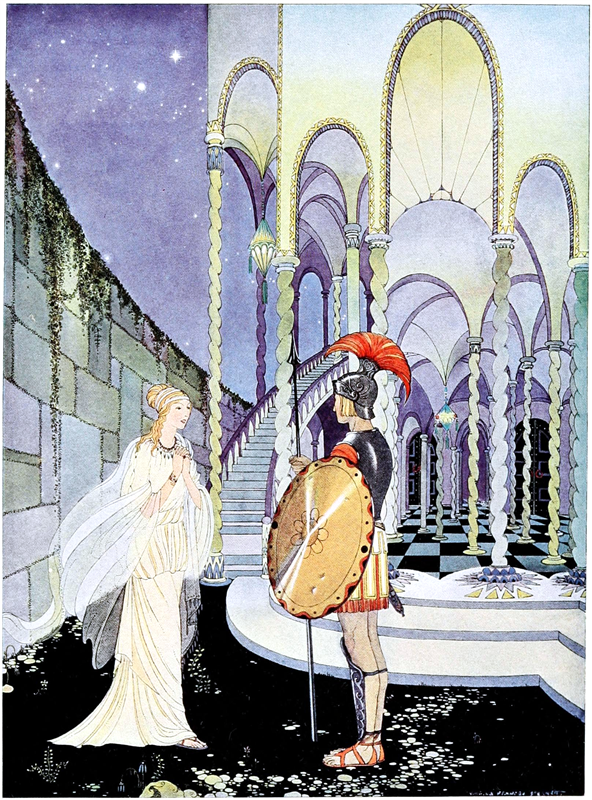
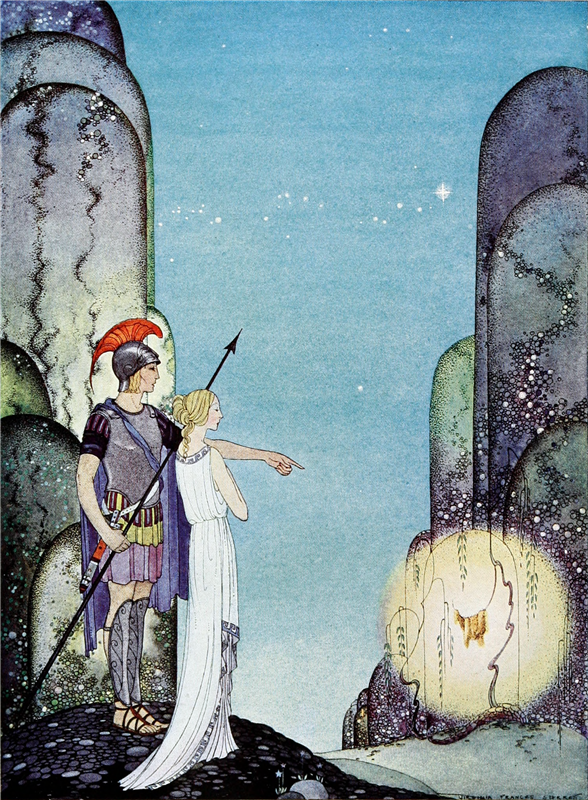
The family moved to California, hoping the warmer weather would assistance meliorate her health; unfortunately, she did not improve and finally went to a sanitorium. There, she started working on a book of her own, both the writer and illustrator. As tuberculosis continued to ravage her trunk, she only drew for short times. Her interpretation of Arabian Nights, a commission taking three years to consummate, her last work before she died, was only thirty years erstwhile. The original Arabian Nights were based on old Arabic folk tales, a topic for many different authors, including stories most Aladdin, Scheherazade, Ali Baba, and Sinbad the Crewman. Many critics believe Sterrett's illustrations for the book are her all-time. In the analogy, They Danced (5.ii.22) her exquisite work and power to use pen and ink to create all-encompassing details attest to her capabilities. She used highlights of yellow/golden and ruddy to accentuate the characters against the deep foreboding backgrounds. Following her expiry, the St Louis Mail service-Dispatch published:
Her achievement was beauty, a frail, fantastic beauty, created with brush and pencil. Virtually unschooled in art, her life spent in prosaic places of the Due west and Middle Due west, she made pictures of haunting loveliness, suggesting Oriental lands she never saw and magical realms no one ever knew except in the dreams of childhood ... Peradventure information technology was the hardships of her own life that gave the young creative person'due south work its fanciful quality. In the imaginative scenes she set downwardly on newspaper she must take escaped from the harsh actualities of existence.[4]
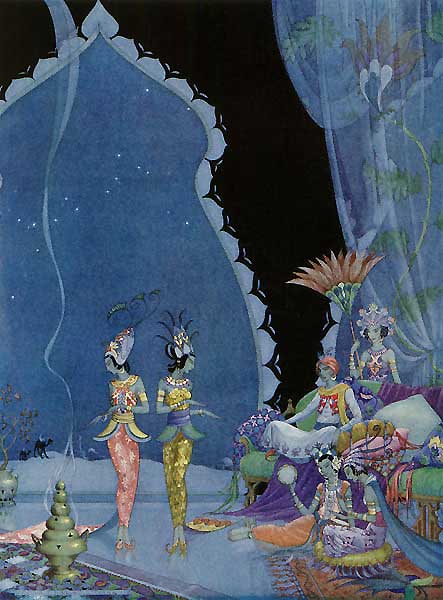
Art Nouveau concepts were found in objects other than paintings, a movement breaking from the past traditional standards. However, with the eruption of World War I and the devastating and bloody battles, the frail, curvy, beautiful lines and colors became inappropriate. Artists began to use the more angular geometric designs of the later art movements. The concepts of fine art nouveau were institute everywhere in architectural details. Gaudi incorporated imaginative shapes for columns, roofs, and walls in his buildings. Tiffany used the translucency of glass to construct his glass windows. Both artists experimented with how they incorporated colour into their designs.
[1] Thompson, J. (1971). The Part of Woman in the Iconography of Art Nouveau.Art Journal,31(2), 158-167. doi:ten.2307/775570
[ii] Fowler, A., Ubeis, J., (2010). Chapters Evolution in Practice, Routledge, p. 128.
[3] Lehmann, H. M. (2007). Glass and Glassware, Lindemann Press, p. 120.
[4] St. Louis Post-Dispatch, 5 July 1931, p. 41.

0 Response to "Gustav Klimt Jewelry When Did It Originate Art Nouveau Jewelry"
Post a Comment